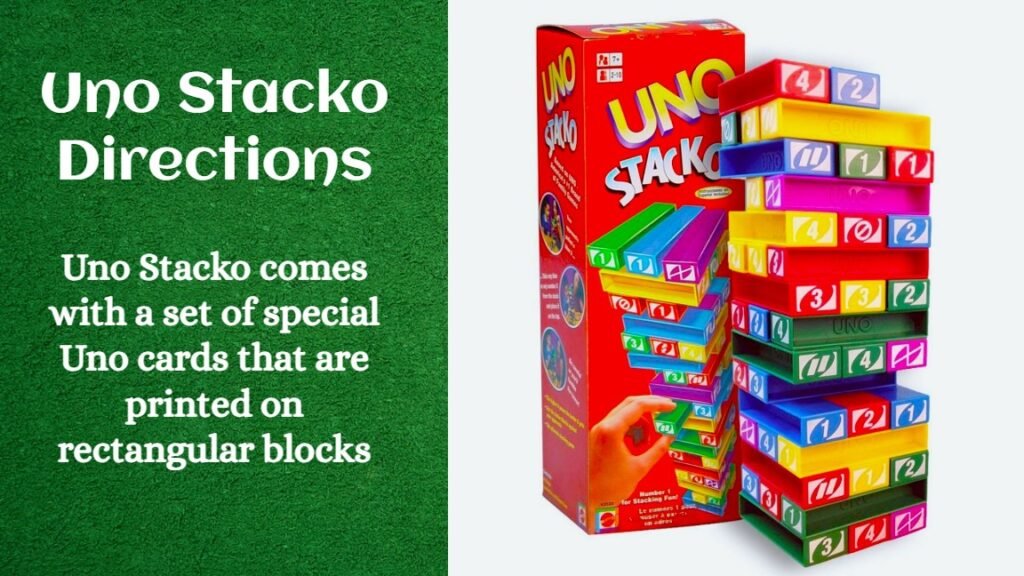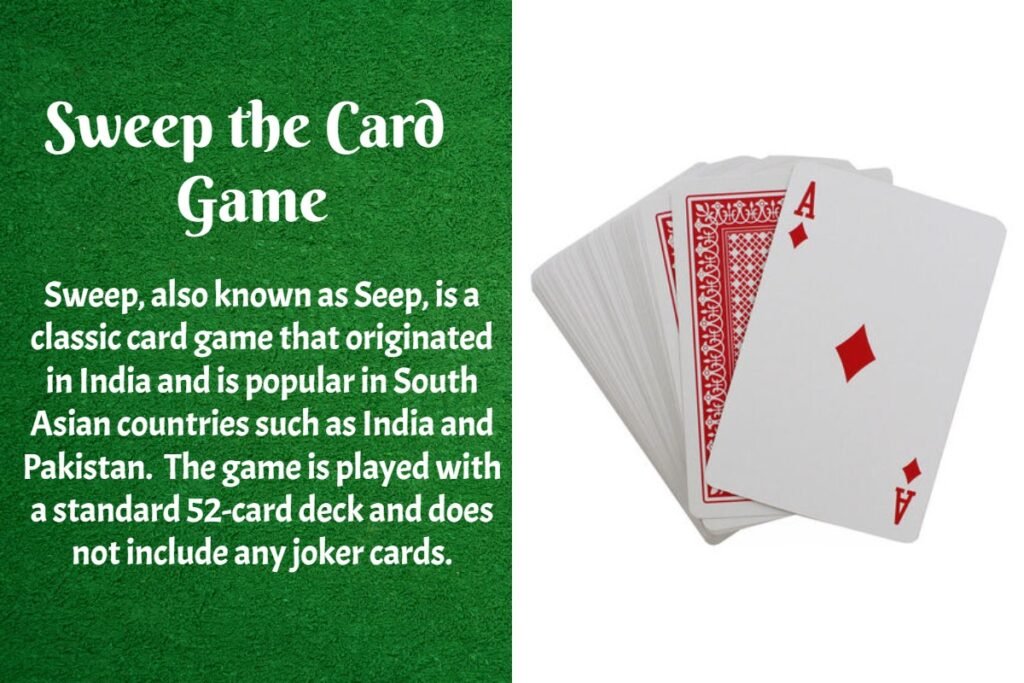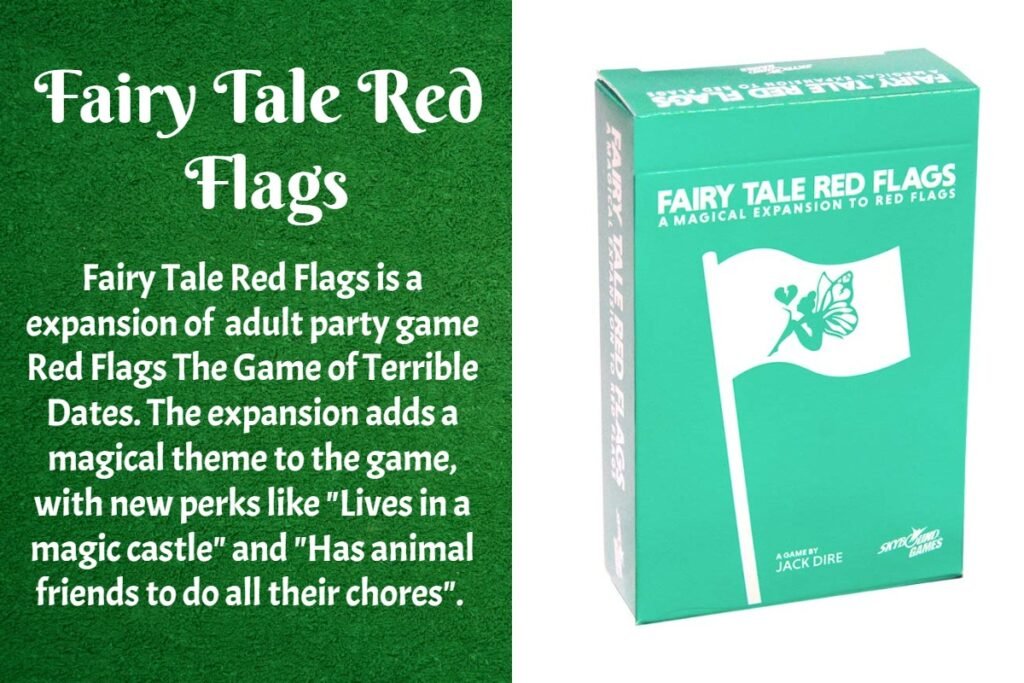UNO Stacko combines the rules of UNO with the stacking and drawing mechanics of Jenga. Players draw blocks from the tower, matching colors or numbers/symbols to the top of the discard pile, just like in UNO, and then stack them on top. The game ends when someone causes the tower to fall, and the last player to successfully stack a block without causing a collapse wins.
UNO Stacko Rules
Uno Stacko is a card game variant of the popular game UNO. Instead of cards, players use colored plastic blocks in red, green, yellow, blue, and purple. Players must use only one hand to pull and place blocks but can switch hands. There are 45 blocks and a loading tray in the UNO Stacko box. The composition of the blocks is as follows: 8 red blocks, 8 blue blocks, 8 yellow blocks, 3 reverse blocks, 2 skip blocks, 4 draw 2 blocks, 1 wild block.

Uno Stacko Dices
Uno Stacko is a variation of the classic Uno card game but with a twist it involves stacking blocks instead of playing cards. Additionally, there are 45 blocks in total, plus a cardboard tray to help you store the blocks back in the box. Uno Stacko is suitable for anywhere from 2 to 10 players and can be played with only one hand at any given time.

Uno Stacko Dices Rules
Uno Stacko comes with a set of special Uno cards that are printed on rectangular blocks. These blocks are usually made of wood or plastic and have Uno card colors (red, yellow, green, and blue) and numbers printed on them, similar to regular Uno cards.

To set up the game, players stack the Uno Stacko blocks into a tower. Each player takes turns removing one block at a time from the tower and must follow specific Uno stacko dice rules when doing so.
How to Play UNO Stacko
The gameplay in Uno Stacko is similar to classic Uno. Players take turns and try to match the color or number of the block they remove from the tower with the topmost block on the stack. If a player can’t make a match, they must draw a special Uno Stacko card from a separate deck and follow its instructions, which could include reversing the order of play or making the next player draw extra cards.
Objective:
The main objective of Uno Stacko is to be the last player remaining with blocks after other players have knocked the tower down.
Setup:
- Stack the Uno blocks to form a sturdy tower.
- Shuffle the Uno Stacko cards and place them face down as the draw pile.
- Each player takes turns drawing a card from the draw pile.
Gameplay:
- Players take turns removing one Uno block from the tower without causing it to collapse.
- The color or number on the block they remove determines the card they draw.
- If a player successfully removes a block without the tower falling, they must follow the card’s instructions (e.g., skip, reverse, draw 2).
- If the tower collapses during a player’s turn, they must draw a number of blocks from the tower equal to the number on the card they drew.
Special Blocks:
Some Uno Stacko sets include special action blocks, similar to Uno cards. These blocks can introduce various rules when drawn. For example, a “reverse” block may reverse the order of play, and a “skip” block can skip the next player’s turn.
Winning:
The game continues until someone causes the tower to collapse. That player loses the game.
Alternatively, you can play with a scoring system, where players earn points for successfully stacking blocks and lose points for causing the tower to collapse. The player with the most points wins.
These rules provide a basic framework for playing Uno Stacko. You can also customize the rules to suit your preferences, such as incorporating house rules or additional challenges.
Uno stacko with dice rules
Uno Stacko is a variation of the popular card game Uno that involves stacking and balancing Uno blocks. Although there isn’t a standard version of Uno Stacko that includes dice, you can create your own rules to incorporate dice for added excitement. Here’s a suggested way to play Uno Stacko with dice:

Dice Setup:
Set up the Uno Stacko tower as you normally would, following the standard Uno Stacko rules. Each block should have different Uno card values.
Dice Rules:
Before a player takes their turn, they must roll a standard six-sided die.
The number rolled on the die determines the action they must take:
- 1: Draw one block from the tower.
- 2: Draw two blocks from the tower.
- 3: Reverse the order of play (if playing with multiple players).
- 4: Skip the next player’s turn.
- 5: Choose one player to draw a block.
- 6: Choose one player to remove a block and reposition it on top of the tower.
Uno Card Rules:
Players must still follow standard Uno card rules, matching numbers or colors when placing blocks on top of the tower.
Winning with dice
The player who successfully removes and places the last block on top of the tower while following Uno card rules and the dice rules wins the game.
Uno Stacko 1994 Rules
Uno Stacko is a variant of the classic Uno card game that incorporates a tower-building element. While the specific rules may have evolved over time, here’s a summary of the Uno Stacko rules as of 1994:
Uno Stacko typically includes the following rules:
- Setup: Stack the Uno Stacko blocks in rows of 3, with each row facing a different direction to create a tower.
- Gameplay: Players take turns removing one block from any row of the tower and then place it on top of the stack. The color or number on the block they remove must match the top block of the stack.
- Special Blocks: Some blocks may have special actions, similar to the Uno card game. For example, there may be “Reverse” blocks or “Skip” blocks.
- Winning: The player who causes the tower to collapse loses the game. The remaining players count the number of blocks they’ve successfully removed, and the player with the fewest blocks wins.
- Draw 2 Rule: Some sources mention a “Draw 2” rule, where if a player successfully removes a particular block (perhaps one with a special symbol), they can instruct another player to draw two extra blocks from the tower.
These rules provide a basic framework for playing Uno Stacko. However, since Uno Stacko may have variations and house rules, it’s advisable to agree on specific rules with your fellow players before starting the game. Additionally, you can refer to the provided sources for more detailed instructions and variations.
Uno Stacko Symbol Meaning
The symbols in UNO Stacko blocks have specific meanings, which are crucial to understanding and playing the game effectively.
Here are the meanings of the symbols commonly found on UNO Stacko blocks:
Numbered Squares (0-9)
These squares represent the number of levels or rows the player must remove or add during their turn. For example, if you draw a block with the number “3,” you must remove three blocks from the tower or add three blocks to the top.
Colored Squares (Red, Yellow, Green, Blue)
Similar to the colored cards in traditional UNO, these squares indicate that the player must perform a corresponding action. For example, a red square might mean that the next player must draw two blocks, just like a red “Draw Two” card in UNO.
Wild Block
This block allows the player to choose a color, similar to a Wild card in UNO. The player can declare any color, and the next player must act accordingly.
Reverse Block
When this block is drawn, the direction of play reverses, just like a Reverse card in UNO.
Skip Block
Like a Skip card in UNO, this block allows the player to skip the next player’s turn.
Draw Two Block
This block forces the next player to draw two blocks from the tower.
It’s important to note that different sets of UNO Stacko may have slight variations in the symbols or rules, so it’s advisable to refer to the specific rules provided with the game set you’re using for any unique symbols or instructions.

Conclusion
Uno Stacko is a popular choice for both Uno lovers and those looking for a new and entertaining party game. Uno Stacko combines the strategy of Uno with the physical dexterity of Jenga. It’s a fun and engaging game requiring careful planning and a steady hand. The inclusion of Uno’s special blocks adds unpredictability and excitement to the gameplay.
Other Uno Versions
FAQs
What is Stacko Uno?
Uno Stacko is a card game variant of the popular game Uno. Instead of using Uno cards, players use colored plastic blocks in red, green, yellow, blue, and purple to build a tower. The blocks have numbers 1-4 printed on them, as well as Skip, Reverse, and Draw 2 blocks. There are two versions of the game: the earlier version requires the use of a die, while later versions eliminate the die, making the gameplay closer to Jenga. Uno Stacko can be played with 2 to 10 players and can last up to 15 minutes.
How do you play Uno stacko?
Uno Stacko is a card game variant of the popular game UNO. Instead of cards, players use colored plastic blocks in red, green, yellow, blue, and purple to build a tower. The blocks have numbers 1-4 printed on them, as well as Skip, Reverse, and Draw 2 blocks. A set of Uno Stacko includes 45 blocks and a tray made out of cardboard where you can store the blocks when not playing. The goal is to move blocks and not cause the tower to fall over, and the player who pulls and places the last block before it falls is the winner.
What is purple in Uno Stacko?
Uno Stacko is a block stacking dexterity game that combines the classic gameplay of Jenga with features from UNO. In versions found on store shelves in the 90s, a die was included that players rolled to determine which block had to be removed. In modern publications of the game, the die has been removed and players choose the block based on which type was removed on the turn before theirs.
How many blocks are in Uno Stacko?
Uno Stacko is a game with colored plastic blocks, typically made of plastic and colored red, yellow, green, blue, and violet. The blocks have numbers 1-4 printed on them, as well as Skip, Reverse, and Draw 2 blocks. There are 45 blocks in each set, plus a tray made out of cardboard where you can store the blocks when not playing.
Discover more from Learning Board Games
Subscribe to get the latest posts sent to your email.




